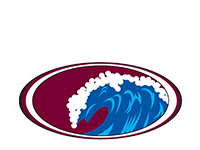
Local kelp beds, an indicator of marine ecosystem health, have bloomed this year due to a combination of favorable ocean conditions and likely the previous efforts of kelp restoration experts. Fish counts are up as well, according to informal counts by divers.
“Everyone notices it in the dive community. Ask anyone, they will tell you there’s more kelp,” said Mike Kuhns, with the dive shop Laguna Sea Sports and who logs 300 dives a year in Laguna.
Last December’s aerial survey of Laguna’s coastline showed 23 acres of kelp north of Main Beach, and 24.3 to the south, almost double the 20-year average of 24.2 acres total, according to aerial photos provided by marine consultants MBC Applied Environmental Sciences in Corona del Mar.
Curtis, an MBC scientist led a seven-year effort to restore kelp off Laguna’s Cress Street beach and other sites, and studied under Dr. Wheeler North, the unofficial godfather of kelp reforestation that pioneered efforts off Palos Verdes in the 1960s.
“If you go to Scotchman’s Cove there is a nice big kelp bed that hasn’t been there since the late 1970s,” said Curtis, describing a popular beach within Crystal Cove State Park.
“A lot of the places hit a maximum in 2010, but about half are hitting their highest kelp density this year. It’s because of the La Nina we’ve had since March of last year. We’ve had really good conditions with only a couple warm months in summer,” said Curtis.
Kelp is dependent on plenty of sunlight and cold water rich in nutrients.
“There’s an inverse relationship with temperature and nutrients,” Curtis said, explaining that nutrient-rich cold water rises, a phenomenon known as upwelling. “In La Nina conditions we essentially have upwelling all year round.”
 Kelp growth is also inhibited by turbidity, water clouded by sediment, pollution or phytoplankton, preventing sunlight from reaching kelp. In coastal areas where there is less storm runoff and turbidity, such as Catalina Island, kelp grows in water up to 100 feet deep, while in mainland coastal areas kelp rarely thrives deeper than 60 feet, said Dave Meyer, a retired science teacher and dive instructor who planted kelp at Little Corona, outside the Newport Harbor. That site that was so successful that it served as a kelp donor site to other restoration projects.
Kelp growth is also inhibited by turbidity, water clouded by sediment, pollution or phytoplankton, preventing sunlight from reaching kelp. In coastal areas where there is less storm runoff and turbidity, such as Catalina Island, kelp grows in water up to 100 feet deep, while in mainland coastal areas kelp rarely thrives deeper than 60 feet, said Dave Meyer, a retired science teacher and dive instructor who planted kelp at Little Corona, outside the Newport Harbor. That site that was so successful that it served as a kelp donor site to other restoration projects.
Recent weather and water conditions allowed natural reproduction of kelp by spores all along the Orange County coastline, Meyer said.
Fish counts seem to be rising along with the flourishing kelp beds.
“Before we were counting them in the rocks, where they would hide. Now they are out in the kelp beds. I did fish counts before the kelp growth, and now, and there are more fish now. There are more places for fish to hide. There is more food too,” said Nancy Caruso, a Garden Grove biologist, who has lead efforts to restore kelp and abalone in Laguna.
“A real healthy kelp canopy creates the environment and does help in the (fish) population,” said Mike Hanson, a 25-year captain and president of Dana Wharf Sport Fishing, though kelp-growing conditions are not necessarily a boon to recreational anglers.
“The fish don’t really bite when the water’s cold. Cold water puts them into a semi-hybernation state. That’s another reason the fish population is up so much in the kelp beds: they didn’t really bite much last year,” said Hanson.
Flourishing kelp beds that provide habitat for fish prove alluring to free divers and snorkelers also. Even so, lifeguards say kelp plays an inconsequential role in rescues, despite a recent death by an experienced diver last month.
“Divers die in the kelp in Laguna Beach from time to time, but I wouldn’t say kelp is any worse a cause of death than before,” said Sgt. John Hollenbeck, of the Harbor Patrol office that oversees Dana Point, Newport and Sunset harbors.
Last month, Andrew Brislen was found near Laguna’s Picnic Beach in kelp after free diving alone. Though a cause of death is still pending, his wife suggested he may have simply blacked out.
Laguna Beach Marine Safety Chief Kevin Snow is also unfazed by the kelp.
“I don’t think it really effects our operations. If you are a boater driving into kelp it may affect you. But it is your job to be aware of your surroundings and not drive into kelp. From a rescuer point of view, swimming through kelp is one of the many things lifeguards are trained to do. It is not a significant factor when doing rescues.”
Wheeler North Link: http://eands.caltech.edu/articles/LXVI/north.html




